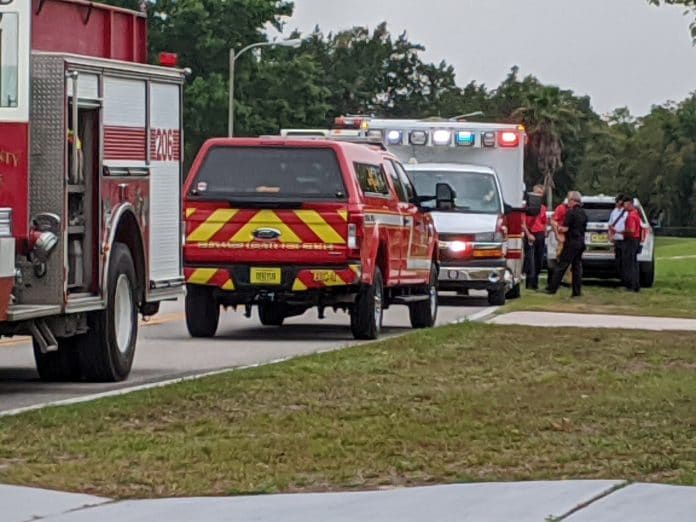Hernando County Fire and Emergency Services (HCFES) Chief and Director of Emergency Services Scott Hechler provided a brief, but comprehensive update of the state of his department at the February 8, 2022 Board of County Commissioners meeting. Presenting after Hechler was Kenneth Wannen, Division Chief of Fire and Emergency Services. Wannen also serves as the HCFES Public Information Officer (PIO). Wannen explained possible reasons for increased response times for fire and emergency services.
Hechler began by reporting statistics for 2021. Most relevant to the discussion was that the Average Emergency Medical Services (EMS) response time for 2021 was 6 minutes 44 seconds. The average call volume in 2021 for EMS was 29,206 calls, resulting in 22,327 EMS Patient Transports. Call volume has increased 19.03% since Fiscal Year (FY) 2019-2020.
Hechler added that a large driver behind the change was in the spring of 2020, call volumes decreased due to people staying home during the initial “lockdown” phase of the pandemic.
Wannen addressed the concerns of the board stemming from comments from Doug Davis, who brought his concerns about EMS response times to the board at the January 25, 2022 regular meeting.
Wannen reported that prior to the COVID pandemic, EMS units were typically placed back into service 15 minutes after arriving at a hospital to deliver a patient.
During the pandemic, EMS units were given an extra 5 minutes, however, during the past two years, and in years prior, a unit could advise that they needed extra time, such as for decontamination of the unit or staff delay. When ambulances are delayed more than 20 minutes, other ambulances take their place, moving into the area usually covered by the delayed unit.
Wannen reported that ultimately, the unit dispatched to the Davis residence was not delayed by a hospital backup or other transportation issue, but that there was a simultaneous 911 call at that time. “Because there were two 911 calls coming into the City of Brooksville at the same moment in time, the outcome would have been exactly the same.”
“ER (Emergency Room) Holds” are a contributing factor to the recent backups. When a patient is brought to the ER, and it is determined that they should be admitted to the hospital, they may have to wait in the ER until a regular bed is available. Such patients usually require monitoring or oxygen.
Wannen cautioned that the reasons for hospital delays were questions for each hospital, but gave the HCFES perspective.
“Any given ER that we have typically has between 15-20 beds, they usually allocate about 10 hallway surge stretchers, plus they have a pediatric and a fast-track, so you’re looking at an overall [ER] capacity of about 20-30 beds. Of those beds, only a certain portion have cardiac monitors, and the capability to administer oxygen (without having to use portable tanks or portable monitors).”
Wannen explained that the number of ER holds can give HCFES an idea about how their day is going to go. “[When we see] between 11-20 beds … that are awaiting admission to the floor, that’s less ability that we have to transfer patients in a timely manner.”
Data collected from Bravera Health Brooksville shows an average of 29 minutes, 55 seconds from EMS arrival until signing off to a nurse to continue care during the month of January. For Bravera Health Spring Hill, the time was 19 minutes, 7 seconds. Oak Hill’s transfer of care duration is reported to be 32 minutes, 53 seconds. The number of ER holds was not available for Oak Hill.
Commissioner Jeff Holcomb posed a “perfect world” scenario, “The rescue gets [to the hospital], ready to take the patient off [the ambulance] there’s a bed ready, there’s a person ready to check that [patient] in. What does that process take in a perfect world?” Wannen responded, “In a perfect world, we’re out of the ER in less than 10 minutes.” He added that HCFES leaves the metric at 20 minutes to allow for extenuating circumstances.
Oak Hill receives most of the EMS transports, followed by Bravera Health Brooksville. Bravera Health Spring Hill receives an average of 8 patients in a 24-hour period.
While the patient’s condition is a factor, the patient ultimately chooses the hospital where EMS will take them. Oak Hill’s population is largely due to the demographics of the area and its proximity to doctors with credentials at Oak Hill. Wannen stated that patients are alerted to hospital conditions en route.
HCFES is governed by a federal law called the Emergency Medical Treatment & Labor Act (EMTALA). This law preempts any state or local laws. As long as a patient is on an HCFES stretcher, and not signed over to the hospital, the responsibility remains with this agency. According to Wannen, there could be a statement in the law that would hold a hospital in violation of the law if it was found they deliberately delayed taking responsibility of a patient, “It may be a violation to leave us parked in the hall, but from what I’ve seen there’s nothing anywhere that defines fines or anything else.”
There are state laws that govern healthcare in Florida, however, it was not clear during the meeting how changing state regulations would have any effect over EMTALA.
Editor’s Note and Correction: In the January 28, 2022 issue, The Hernando Sun incorrectly reported the EMS arrival time to the Davis home as 10:04. EMS arrived at the Davis home at 10:10. The total response time was 18 minutes. The Hernando Sun regrets this unintentional error and we maintain a policy of swiftly correcting the record after errors are brought to our attention.

